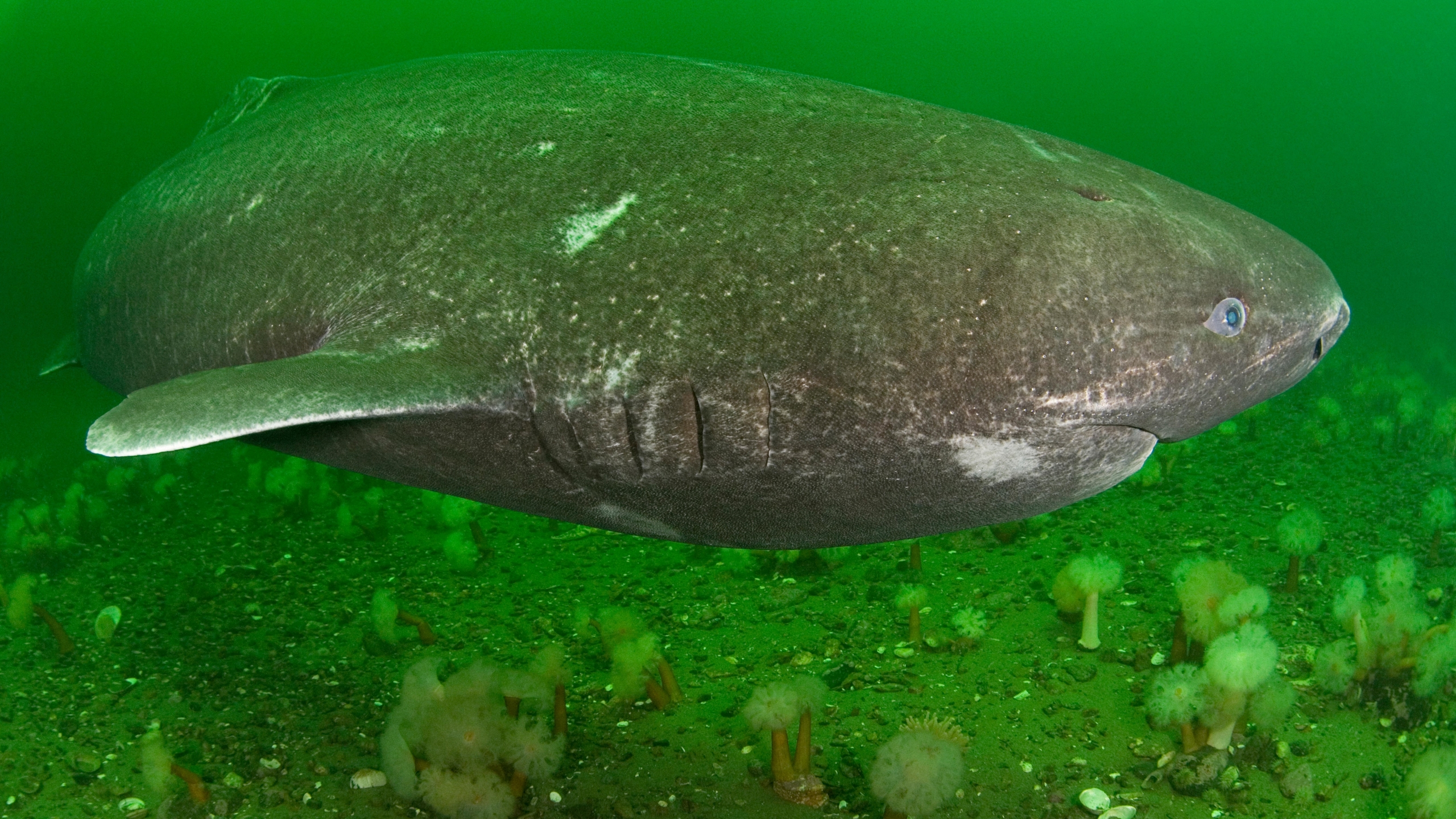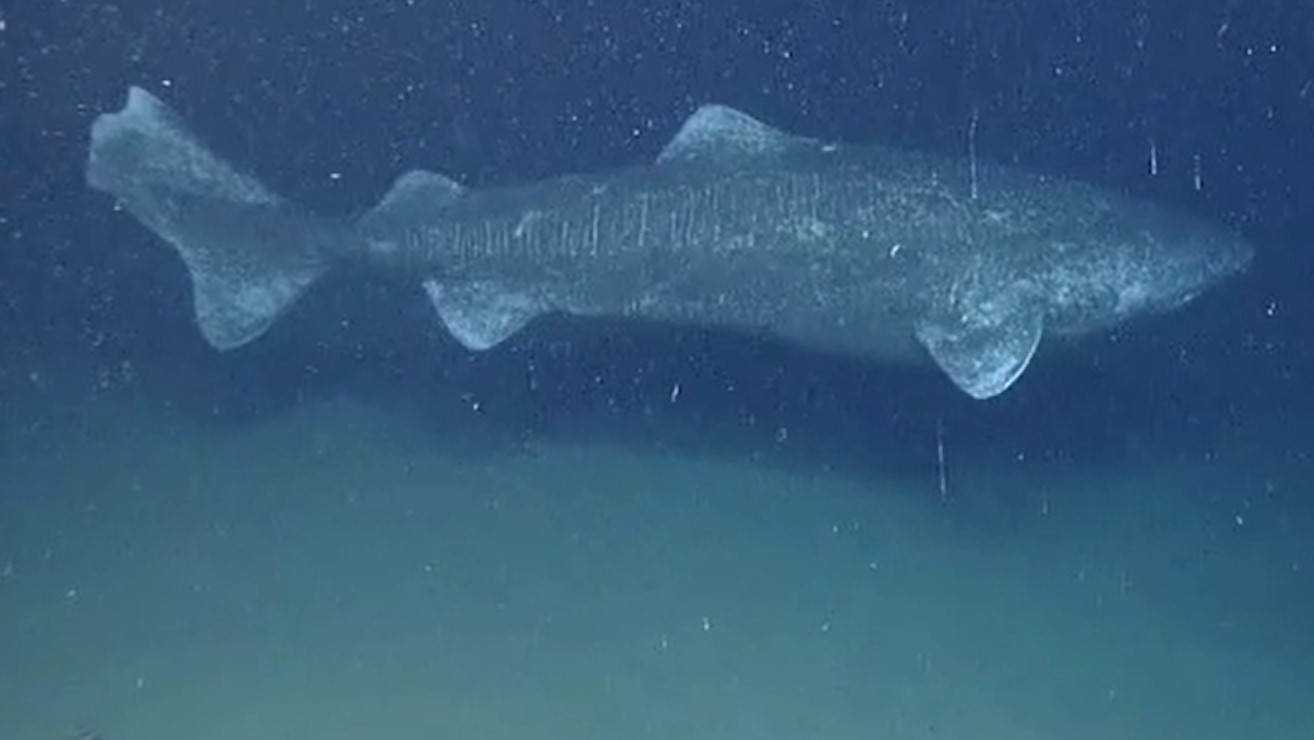
What is the oldest shark?
At nearly 400 years old, the oldest-known living vertebrate crossed the oceans the same time as the Mayflower.

Sharks are often called "living fossils," and for good reason: The first sharks appeared in the fossil record roughly 450 million years ago and have lived through all five mass extinctions, including the one that wiped out the nonavian dinosaurs. In addition to being long-lived as a group, individual sharks have long life spans. So just how long can sharks live, and what's the oldest shark on record?
On the lower end of the longevity scale, the great hammerhead shark (Sphyrna mokarran) lives about 44 years, although one individual caught by a fisher in Florida was estimated to be as old as 50. The great white shark (Carcharodon carcharias) can live up to 70 years, according to a 2014 study in the journal PLOS One.
But of all the shark species, one stands out for its mind-boggling longevity.
Oldest shark on Earth
"The Greenland shark is the longest-lived shark species by far," Brynn Devine, a marine biologist at the University of Windsor in Ontario and an expert in Greenland shark conservation, told Live Science.
Related: The longest-living animals on Earth
Greenland sharks (Somniosus microcephalus) scour the ocean floor in the North Atlantic and Arctic. These huge sharks, some the size of great whites, are truly remarkable.
"Greenland sharks are not just the oldest sharks," Devine said, "but they are possibly the oldest animals with backbones, which is crazy to think about."
In a 2016 study in the journal Science, researchers determined that the average age of a group of 28 Greenland sharks in their sample was 272 years old. The oldest in the group was estimated to be 392 years old, plus or minus about 120 years. That led to a widely held — but now debunked — misconception that the oldest shark was 512 years old.
The oldest Greenland shark
In a 2016 study in the journal Science, researchers determined that the average age of a group of 28 Greenland sharks in their sample was 272 years old. The oldest in the group was estimated to be 392 years old, plus or minus about 120 years. That led to a widely held — but now debunked — misconception that the oldest shark was 512 years old.
But even at almost 400 years old, the Greenland shark identified in the study could have been traversing Earth's oceans around the same time the Mayflower was transporting the Pilgrims to the New World.
John Fleng Steffensen, professor of marine biology at the University of Copenhagen, was an author on the Science paper. "The age of the largest shark we have caught was between 272 and 512 years, and that was 'only' about 502 cm (16.4 feet) long. We believe Greenland sharks can be up to 550 cm (18 feet) long, and since they are growing slower the larger they are, a 550 cm long female may be maybe 100 years older."

Typical aging methods didn't work for that 2016 study. "Aging is typically done by counting growth rings in calcified structures, like vertebrae or spines," which are laid down seasonally, like tree rings, Devine said. But those methods can be inaccurate if the shark doesn't grow at predictable rates throughout its life, so researchers usually check dating from this method against other evidence. Age estimates can be verified with mark-recapture studies, which involve tracking a population of animals over time.
Brynn Devine is a fish biologist and Arctic fisheries advisor for Oceans North Canada. Her research focuses on sustainable fisheries and conservation of deep-water species and ecosystems. Brynn continues to work on bycatch species caught in northern fisheries, particularly Greenland shark. She earned her PhD from Memorial University of Newfoundland, where her research explored the environmental drivers of deep-sea fish distributions in Atlantic Canada and the Eastern Arctic.
"For Greenland sharks, conventional dating methods simply don't work," Devine said. Most deep-sea-shark skeletons don't calcify enough to produce usable growth rings, and these sharks lack the spines used for dating in other sharks. Even if scientists could determine ages from growth rings or spines, manually verifying the sharks' ages with annual mark-recapture studies is out of the question, given that Greenland sharks in any study will easily outlive a researcher's great-grandchildren.
Instead, researchers relied on radiocarbon dating to estimate the sharks' ages. For this, the researchers sampled tissue from the eye lenses, which form at birth, and determined each animal's age based on the ratios of carbon isotopes, or versions of the element, in their eyes. Because radiocarbon dating is rather imprecise, and the exact physics of how carbon behaves in a Greenland shark's body are not known, there is a large margin of error in the final estimates.
"Unfortunately, there aren't a lot of alternative techniques, so this is a major challenge in aging deep-sea sharks," Devine said.
Because researchers know so little about the Greenland shark's metabolism, it is unclear what enables them to live so long. Steffensen said the low temperatures in which they live probably contributes, as it lowers their metabolic rate. Animals with lower metabolic rates tend to live longer than those with fast ones. "There are probably several other factors that we do not know yet," he said.
One thing we do know, according to Devine, is that female Greenland sharks might not reach sexual maturity until 134 years old. To put that into perspective, the person widely considered to be the oldest human to have ever lived, Jeanne Calment, died at the age of 122, having outlived her own grandchildren. A Greenland shark born on the same day as Calment would still have been awaiting shark puberty when she died.
"They are truly remarkable deep-sea animals," Devine said.
Editor's Note: This article was originally published in August, 2021 and updated April 25, 2023
Sign up for the Live Science daily newsletter now
Get the world’s most fascinating discoveries delivered straight to your inbox.

Cameron Duke is a contributing writer for Live Science who mainly covers life sciences. He also writes for New Scientist as well as MinuteEarth and Discovery's Curiosity Daily Podcast. He holds a master's degree in animal behavior from Western Carolina University and is an adjunct instructor at the University of Northern Colorado, teaching biology.










